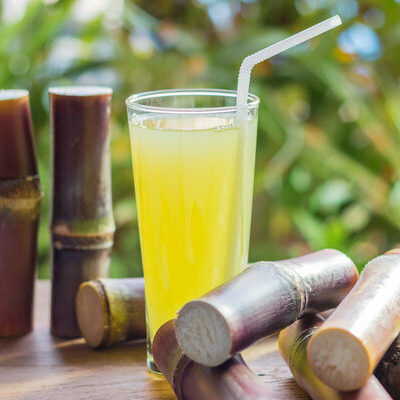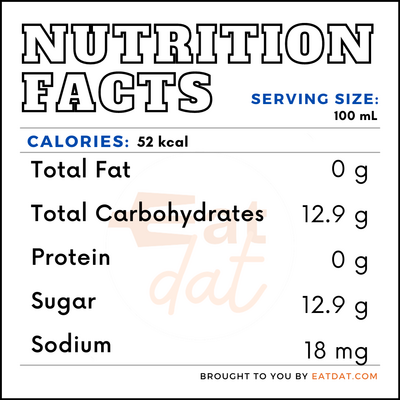
Sugarcane Juice
What is Sugarcane Juice?
Sugarcane juice is the cloudy, white or yellow liquid extracted from the sugarcane plant. This drink is around 70% water, 15% fiber, and 15% sucrose. This juice is processed to make sugar, brown sugar, and molasses, as well as some rums and liqueurs. This drink is sweet and has a syrupy consistency. It is popular in various regions of India, Africa, and Asia.
The most common types of sugarcane are:
- Chewing canes (Usually planted for consumption)
- Syrup canes
- Crystal canes
Origin of sugarcane juice
The origin of this juice can be linked to the cultivation of sugarcane. The first account of the cultivation of sugarcane dates back to 8,000 BCE, around the Polynesian region. The long existence of sugar in Greece and Rome indicates the prolonged presence of sugarcane. Also, sugarcane cultivation was recorded in China around 640 CE, using technology from India. Records show that this juice has traditionally been used in Eastern medicine to treat various illnesses.
In 1390, advanced means of extracting sugarcane juice were developed, increasing the quantity of juice produced. In the 15th century, the cultivation of sugarcane in America began. The juice was extracted and used to make white sugar using the Howard Vacuum Pan. Using this device, sugar was made by boiling the juice in a closed kettle held under a vacuum. While there are other modern sources for creating sugar and sweeteners, sugarcane continues to be grown in over 80 countries around the world.
Nutrition
A 100ml serving size contains:

While sugarcane juice’s sweetness is often mistaken for being unhealthy, it is actually packed with health benefits. This juice contains antibiotics that may help fight infections. Also, it has a diuretic property that helps cleanse the kidney and prevent kidney stones. Additionally, it can strengthen the liver, and is widely used to treat jaundice (yellow pigmentation of the skin).
Furthermore, sugarcane is loaded with antioxidants that can combat free radicals and maintain the immune system. This juice has polyphenols, which show promise for treating diabetes, although this research is preliminary, meaning diabetics should approach with caution. However, excessive consumption of sugarcane has been linked to some side effects. These include insomnia, dizziness, stomach pain, and consistent weight loss due to the presence of policosanol. This juice has also been linked to the thinning of the blood.
Commercial production
The commercial production of this juice uses manual extraction by means of a roller mill tandem. Once the juice is extracted from the sugarcane plant by the roller, it is then filtered. After filtration, the juice is stabilized using calcium hydroxide to reach a pH of 7.5. Finally, the juice can be bottled or sent off for further processing.
Application
This juice can be easily made at home, using fresh sugarcanes. Fresh canes should be adequately washed to get the best nutrients. Bear in mind, this juice goes bad quickly due to yeast and bacteria. To preserve it, store it in airtight bottles, and keep it inside the fridge to prolong its shelf life for about a week. Sugarcane juice can also be frozen for several months.
Sugarcane juice recipes
This juice blends well with other foods. Some popular recipes include:
- Lemon Chicken with Sugarcane Juice
- Sugarcane and Ginger Granita
- Zanzibari Pressed Sugarcane Drink
- Sugarcane Juice Pongal
- Karimbu Juice
FDA regulation
The Food & Drug Administration does not have specific regulations for sugarcane juice. However, they do regulate cane syrup, which is defined as the liquid food derived by concentration and heat treatment of the juice of sugarcane. Cane sirup must not contain less than 74 percent of soluble solids from sugarcane juice. Also, the FDA provides guidance for labeling sweeteners obtained from this juice. The organization insists that sweeteners or products derived from sugarcane should not be referred to or declared as “evaporated cane juice”, as that is misleading.
References
Singh, Amandeep, et al. “Phytochemical Profile of Sugarcane and Its Potential Health Aspects.” Pharmacognosy Reviews, U.S. National Library of Medicine, 2015, pubmed.ncbi.nlm.nih.gov/26009693/.
“A Brief History of Real Sugar: The Story of Sugar Cane.” The Sugar Association, 17 Dec. 2019, www.sugar.org/blog/a-brief-history-of-real-sugar-the-story-of-sugar-cane/
Center for Food Safety and Applied Nutrition. “FDA Releases Guidance for the Labeling Term ‘Evaporated Cane Juice.’” U.S. Food and Drug Administration, FDA, www.fda.gov/food/cfsan-constituent-updates/fda-releases-final-guidance-regarding-food-labeling-term-evaporated-cane-juice.
